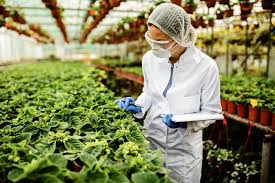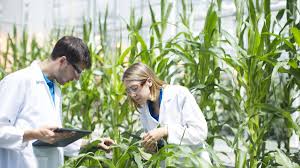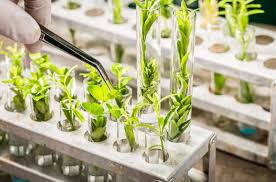Biotechnology is not a new era of scientific endeavour: microorganisms have been used to produce food such as beer, vinegar, yoghurt, and cheese for over 8 millennia.
Simply put, biotechnology is the use of living cells or microorganisms (e.g. bacteria) in industry and technology to manufacture drugs and chemicals, break down waste, etc.
More technically put, biotechnology is an area of multidisciplinary science, involving a variety of distinct subjects, where living organisms or their useful parts are put into effective use to cater for the welfare of humanity. It may be grouped into:
1. Conventional Biotechnology
2. Modern Biotechnology
Raed Also: Blackleg (cruciferous plants): Description, Damages Caused, Control and Preventive Measures
Relevance of Biotechnology to Agricultural Development

Biotechnology is considered a powerful tool that can, in a quick and thorough manner, bring what is most lacking in agriculture. Questions of safety of biotechnology products to humans and the environment have been considered alongside biotechnology programmes.
In most developing countries of West and Central Africa where food is produced, for instance, famine, poverty, and malnutrition remain huge constraints in rural as well as urban areas.
Interestingly, though, agriculture, which makes up forty percent of export revenue and thirty-five percent of the gross domestic product of West and Central African revenue, employs seventy percent of the labour force and covers endless agro-ecological lands.
Significantly, in many industrialized countries, biotechnology has contributed to progress in agriculture, while in developing countries, it comes to add itself to the many technological tools to achieve crucial productivity and sustainability targets, to increase food production on the same land surface areas or less, with added nutritional value and projected lesser negative impact on the environment.
However, large-scale use of biotechnology has its own constraints: skilled human resources are limited; material and financial resources are lacking; the controversies about some agricultural biotechnologies, such as genetic engineering and products from this new technology, remain widespread and time-consuming.
In any case, given the skyrocketing rural population growth and its dependency on agricultural production systems highly vulnerable to climatic changes, and the scarcity of fertile lands per head, the need to increase and improve agricultural production has become definitely very important.
Potential of Biotechnology in Agriculture and Related Fields
The emergence of biotechnology over the last few decades has opened new doors for increased productivity not only for agriculture but also in medicine and industry.
It is of particular relevance to developing countries that are confronted with an ever-increasing population, food shortage, and scarcity of economic resources.
Harnessing of solar energy to improve photosynthetic bacteria as well as utilization of agricultural and organic wastes to produce methane using biogas plants are also aspects of biotechnology in vogue.
The same is true of biological nitrogen fixation, a prerogative of certain free-living or symbiotic anaerobic and photosynthetic bacteria and algae. Biotechnology has been employed in biofuel production and in biological clean-up of contaminated soil.
Applied to the economies of countries in the sub-region, biotechnology offers additional technological opportunities capable of responding to the constant demand for food and to reducing vulnerability in the agricultural sector.
As a result, it contributes to income generation, improvement of nutrition, and preservation of natural resources and ecosystem services. It is necessary to ascertain whether biotechnologies can supply rapid, safe, cost-effective solutions to the intractable biotic and abiotic constraints.
The institutional and infrastructure constraints to agriculture are amenable to positive human intervention and could facilitate rapid adoption of the yield and quality enhancing biotechnologies.
Whether biotechnological solutions are employed is a matter of consumer demand and need, and the resolve of politicians and regulators to deal with these issues in a science and fact-based manner with due resolve.
Raed Also: Blackleg (cruciferous plants): Description, Damages Caused, Control and Preventive Measures
Types of Biotechnology in Agriculture

1. Conventional Biotechnology and Its Application in Agriculture
In the early days, biotechnologists used living organisms for the manufacture of a variety of useful materials. Whatever by-products were obtained during normal cell growth were used by people.
For example, during the normal growth of yeast cells in grape juice, sucrose is converted to ethanol and this fermented juice, containing alcohol, is used as wine. Similarly, Penicillium notatum and P. chrysogenum produce the antibiotic penicillin as a by-product of their secondary metabolism and this compound is used to fight microbial diseases.
Microbial production of glycerol by yeast, acetone and butanol fermentation using Clostridium acetobutylicum, citric acid production by Aspergillus niger, and streptomycin production using Streptomyces griseus are some of the fields developed under conventional biotechnology.
2. Modern Biotechnology and Its Role in Agricultural Innovation
More recently, plant tissue culture or micropropagation has become a useful technology, involving the principle of totipotency, enabling a cell to segment into a whole plant in the proper medium.
The production of biotechnology-based plants, such as orchids, bamboos, and a host of others has led to export-oriented industries in some developing countries like India. Rapid production of disease-free clones of crops like yam, cassava, banana, and plantain has been possible through tissue culture technique.
Modern biotechnology enables an organism to produce a totally new product, which the organism does not or cannot produce in its normal course of life. Since this means a new genetic potential can be engineered in an organism, this technology is also called genetic engineering.
Technically put, genetic engineering is a technology in which a gene or genes are taken from one organism (the donor) or are synthesized de novo (afresh), possibly modified, and are then inserted into another organism (the recipient) in an attempt to transfer a desired trait or character.
The technique is also called genetic modification (GM), gene manipulation, recombinant DNA technology, gene splicing, bioengineering … and many other things!
Similar cell-fusion between plants and microorganisms through protoplast fusion and transfer of nitrogen-fixing nodules, specific genes from legumes to non-legumes, has led to interspecific hybridization, and the impact of these methodologies in various facets of agriculture cannot be over-emphasized. Basic techniques, which stimulate the progress of modern biotechnology include:
i. Recombinant DNA manipulation (genetic engineering)
ii. Plant and animal tissue culture
iii. Protoplast fusion
iv. Monoclonal antibodies
v. Protein engineering
vi. Immobilized enzymes and cell catalysis
vii. Biosensors
viii. Computer-aided bioprocess
ix. New reactor design
x. DNA transfer into living cells
xi. Polymerase chain reaction
xii. Chromosome engineering
Do you have any questions, suggestions, or contributions? If so, please feel free to use the comment box below to share your thoughts. We also encourage you to kindly share this information with others who might benefit from it. Since we can’t reach everyone at once, we truly appreciate your help in spreading the word. Thank you so much for your support and for sharing!

